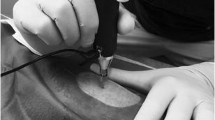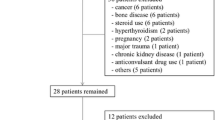Abstract
Bone geometry is a major determinant of the mechanical resistance of bone. Mechanical strength of the vertebrae depends on the cross-sectional area of the vertebral body and on the size of the posterior arch. Smaller bone width is associated with higher risk of stress fracture. A longer femoral neck axis and a more open neck-shaft angle are associated with higher risk of cervical hip fracture. No consistent association between the femoral neck width and the cervical fracture risk was found. Areal bone mineral density (aBMD) is not a good tool for the identification of elderly men with high fracture risk. Fracture risk increases with decreasing aBMD, but only a minority of men who will sustain an osteoporotic fracture are identified by a given threshold of baseline aBMD. Bone width seems to be an independent predictor of the fracture risk in elderly men, and its assessment can improve the prediction of fractures in this population.
Similar content being viewed by others
References and Recommended Reading
Fransen M, Woodward M, Norton R, et al.: Excess mortality or institutionalization after hip fracture: men are at greater risk than women. J Am Geriatr Soc 2002, 50:685–690.
Trombetti A, Herrmann F, Hoffmeyer P, et al.: Survival and potential years of life lost after hip fracture in men and age-matched women. Osteoporos Int 2002, 13:731–737.
Currey JD: How well are bones designed to resist fracture? J Bone Miner Res 2003, 18:591–598.
Kannus P, Haapasalo H, Sankelo M, et al.: Effect of starting age of physical activity on bone mass in the dominant arm of tennis and squash players. Ann Intern Med 1995, 123:27–31.
Lassus J, Tulikoura I, Konttinen YT, et al.: Bone stress injuries of the lower extremity: a review. Acta Orthop Scand 2002, 73:359–368.
Beck TJ, Ruff CB, Shaffer RA, et al.: Stress fracture in military recruits: gender differences in muscle and bone susceptibility factors. Bone 2000, 27:437–444.
Beck TJ, Ruff CB, Mourtada FA, et al.: Dual-energy x-ray absorptiometry derived structural geometry for stress fracture prediction in male U.S. Marine Corps recruits. J Bone Miner Res 1996, 11:645–653.
Giladi M, Milgrom C, Simkin A, et al.: Stress fractures and tibial bone width. A risk factor. J Bone Joint Surg Br 1987, 69:326–329.
Armstrong DW, Rue JPH, Wilckens JH, Frassica FJ: Stress fracture injury in young military men and women. Bone 2004, 35:806–816.
Nieves JW, Formica C, Ruffing J, et al.: Males have larger skeletal size and bone mass than females, despite comparable body size. J Bone Miner Res 2005, 20:529–535.
Protzman RR: Stress fractures in men and women undergoing military training. J Bone Joint Surg Am 1977, 59:825.
Griffin NL, Richmond BG: Cross-sectional geometry of the human forefoot. Bone 2005, 37:253–260.
Pouilles JM, Bernard J, Tremollières F, et al.: Femoral bone density in young male adults with stress fractures. Bone 1989, 10:105–108.
Duan Y, Seeman E, Turner CH: The biomechanical basis of vertebral body fragility in men and women. J Bone Miner Res 2001, 16:2276–2283.
Gilsanz V, Boechat MI, Gilsanz R, et al.: Gender differences in vertebral sizes in adults: biomechanical implications. Radiology 1994, 190:678–682.
Gilsanz V, Loro ML, Roe TF, et al.: Vertebral size in elderly women with osteoporosis. Mechanical implications and relationship to fractures. J Clin Invest 1995, 95:2332–2337. This paper introduces the biomechanical analysis of vertebral fractures in women, especially the mechanical terms, and shows that bone geometry determines the fracture risk independently of bone mineral density. Despite its age, still a reference paper and a major contribution to the subject.
Van Pottelbergh I, Goemaere S, Zmierczak H, et al.: Deficient acquisition of bone during maturation underlies idiopathic osteoporosis in men: evidence from a threegeneration family study. J Bone Miner Res 2003, 18:303–311.
Seeman E, Duan Y, Fong C, Edmonds J: Fracture site-specific deficits in bone size and volumetric density in men with spine or hip fractures. J Bone Miner Res 2001, 16:120–127. One of thefirst papers indicating the role of bone size as the determinant of risk of osteoporotic fractures in elderly men.
Duan Y, Turner CH, Kim BT, Seeman E: Sexual dimorphism in vertebral fragility is more the result of gender differences in age-related bone gain than bone loss. J Bone Miner Res 2001, 16:2267–2275.
Pande I, O’Neill TW, Pritchard C, et al.: Bone mineral density, hip axis length and risk of hip fracture in men: results from the Cornwall Hip Fracture Study. Osteoporos Int 2000, 11:866–870.
Greenspan SL, Lyers ER, Maitland LA, et al.: Trochanteric bone mineral density is associated with type of hip fracture in the elderly. J Bone Miner Res 1994, 9:1889–1894.
Bergot C, Bousson V, Meunier A, et al.: Hip fracture risk and proximal femur geometry from DXA scans. Osteoporos Int 2002, 13:542–550.
Partanen J, Jämsä T, Jalovaara P: Influence of the upper femur and pelvic geometry on the risk and type of hip fractures. J Bone Miner Res 2001, 16:1540–1546.
Faulkner KG, Cummings SR, Black D, et al.: Simple measurement of femoral geometry predicts hip fracture: the study of osteoporotic fractures. J Bone Miner Res 1993, 8:1211–1217.
Ahlborg HG, Nguyen ND, Nguyen TV, et al.: Contribution of hip strength to hip fracture risk in elderly men and women. J Bone Miner Res 2005, 20:1820–1827.
Rivadeneira F, Houwing-Duistermaat JJ, Beck TJ, et al.: The influence of an insulin-like growth factor I gene promoter polymorphism on hip bone geometry and the risk of nonvertebral fracture in the elderly: the Rotterdam Study. J Bone Miner Res 2004, 19:1280–1290.
Filardi S, Zebaze RMD, Duan Y, et al.: Femoral neck fragility in women has its structural and biomechanical basis established by periosteal modeling during growth and endocortical remodeling during aging. Osteoporos Int 2004, 15:103–107.
Cody DD, Divine GW, Nahigian K, Kleerekoper M: Bone density distribution and gender dominate femoral fracture risk predictors. Skeletal Radiol 2000, 29:151–161.
Glüer CC, Cummings SR, Pressman A, et al.: Prediction of hip fractures from pelvic radiographs: the study of osteoporotic fractures. The Study of Osteoporotic Fractures Research Group. J Bone Miner Res 1994, 9:671–677.
Peacock M, Liu G, Carey M, et al.: Bone mass and structure at the hip in men and women over the age of 60 years. Osteoporos Int 1998, 8:231–239.
Melton LJ III, Atkinson EJ, O’Connor MK, et al.: Bone density and fracture risk in men. J Bone Miner Res 1998, 13:1915–1923.
Johnell O, Kanis JA, Oden A, et al.: Predictive value of BMD for hip and other fractures. J Bone Miner Res 2005, 20:1185–1194.
Szulc P, Munoz F, Duboeuf F, et al.: Bone mineral density predicts osteoporotic fractures in elderly men: the MINOS study. Osteoporos Int 2005, 16:1184–1192.
van der Klift M, de Laet CEDH, McCloskey EV, et al.: Risk factors for incident vertebral fractures in men and women: the Rotterdam Study. J Bone Miner Res 2004, 19:1172–1180.
Fujiwara S, Kasagi F, Masunari N, et al.: Fracture prediction from bone mineral density in Japanese men and women. J Bone Miner Res 2003, 18:1547–1553.
Nguyen TV, Eisman JA, Kelly PJ, Sambrook PN: Risk factors for osteoporotic fractures in elderly men. Am J Epidemiol 1996, 144:255–263.
de Laet CEDH, van der Klift M, Hofman A, Pols HAP: Osteoporosis in men and women: a story about bone mineral density thresholds and hip fracture risk. J Bone Miner Res 2002, 17:2231–2236.
Nguyen ND, Pongchaiyakul C, Center JR, et al.: Identification of high-risk individuals for hip fracture: a 14 year prospective study. J Bone Miner Res 2005, 20:1921–1928.
Writing Group for the ISCD Position Development Conference: Diagnosis of osteoporosis in men, premenopausal women, and children. J Clin Densitom 2004, 7:17–26.
Schuit SCE, van der Klift M, Weel AEAM, et al.: Fracture incidence and association with bone mineral density in elderly men and women: the Rotterdam Study. Bone 2004, 34:195–202.
Kiel DP, Hannan MT, Broe KE, et al.: Can metacarpal cortical area predict the occurrence of hip fracture in women and men over 3 decades of follow-up? Results from the Framingham Osteoporosis Study. J Bone Miner Res 2001, 16:2260–2266.
Szulc P, Munoz F, Duboeuf F, et al.: Low width of tubular bones is associated with increased risk of fragility fracture in elderly men—the MINOS study. Bone 2006, 38:595–602. This paper presents the use of the external diameter of tubular bone for the prediction of osteoporotic fractures in a long-term prospective study of a large cohort of elderly men. It shows that low bone width is an independent predictor of fractures in men, after adjustment for bone mineral density.
de Laet CEDH, van Hout BA, Burger H, et al.: Bone density and risk of hip fracture in men and women: cross sectional analysis. Br Med J 1997, 315:221–225.
Wang XF, Duan Y, Beck TJ, Seeman E: Varying contributions of growth and aging to racial and sex differences in femoral neck structure and strength in old age. Bone 2005, 36:978–986.
Ling X, Aimin L, Xihe Z, et al.: Very low rates of hip fracture in Beijing, People’s Republic of China. The Beijing Osteoporosis Project. Am J Epidemiol 1996, 144:901–907.
Bertelloni S, Baroncelli GI, Ferdeghini M, et al.: Normal volumetric bone mineral density and bone turnover in young men with histories of constitutional delay of puberty. J Clin Endocrinol Metab 1998, 83:4280–4283.
Gasser T, Sheehy A, Molinari L, Largo RH: Growth of early and late maturers. Ann Human Biol 2001, 28:328–336.
Tommasini SM, Nasser P, Schaffier MB, Jepsen KJ: Relationship between bone morphology and bone quality in male tibias: implications for stress fracture risk. J Bone Miner Res 2005, 20:1372–1380.
Legrand E, Chappard D, Pascaretti C, et al.: Trabecular bone microarchitecture, bone mineral density, and vertebral fractures in male osteoporosis. J Bone Miner Res 2000, 15:13–19.
van der Meulen MCH, Jepsen KJ, Mikic B: Understanding bone strength: size isn’t everything. Bone 2001, 29:101–104.
Author information
Authors and Affiliations
Corresponding author
Rights and permissions
About this article
Cite this article
Szulc, P. Bone density, geometry, and fracture in elderly men. Curr Osteoporos Rep 4, 57–63 (2006). https://doi.org/10.1007/s11914-006-0003-8
Issue Date:
DOI: https://doi.org/10.1007/s11914-006-0003-8




